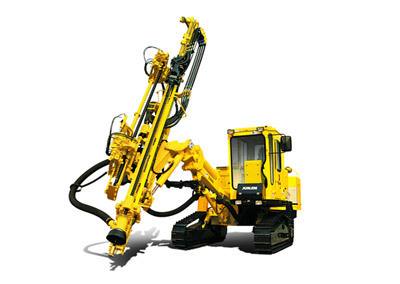Learn about rock drills rig
Related products Link:
A rock drill is something that is used to directly excavate stone. It drills blast-holes in rock formations so that explosives can be placed to blast the rock, and then complete the excavation of stone or other stone work. In addition, the rock drill can be converted into a breaker to break up hard layers such as concrete. Rock drills can be divided into four categories according to their power sources: pneumatic rock drills, internal combustion rock drills, electric rock drills and hydraulic rock drills.
The rock drill operates according to the principle of impact crushing. During operation, the piston performs high-frequency reciprocating motion, constantly impacting the shank. Under the action of the impact force, the sharp wedge-shaped drill bit crushes the rock and digs it into a certain depth to form a dent. After the piston retreats, the drill bit turns a certain angle, the piston moves forward, and when it hits the drill bit again, a new dent is formed. The fan-shaped rock block between the two dents is sheared by the horizontal component force generated on the drill bit. The piston continuously impacts the shank, and continuously inputs compressed air or pressurized water from the center hole of the shank to discharge the rock slag out of the hole, that is, a circular drill hole with a certain depth is formed.
Operating procedures
1. Before rock drilling, check the integrity and rotation status of each component (including rock drill, support or rock drilling rig), add necessary lubricating oil, check whether the air passage, water passage is unblocked, and each connection joint is firm.
2. Knock and ask the roof near the working face, that is, check whether there is live rock or turquoise near the roof and the second gang of the working face, and make necessary treatment.
3. The position of the blast-hole with a flat working surface should be leveled beforehand before rock drilling to avoid slippage or displacement of the blast-hole.
4. It is strictly forbidden to play dry eyes. We must adhere to wet rock drilling. When operating, turn on the water first, then turn on the wind. When stopping drilling, turn off the wind first, and then turn off the water. When opening the eye, work at low speed first, and then drill at full speed after drilling to a certain depth.
5. The drill staff are not allowed to wear gloves when drilling holes.
6. When using the air leg to drill the hole, pay attention to the standing posture and orientation, and must not rely on the body to pressurize, let alone stand under the drill rod in front of the rock drill to prevent the broken drill from hurting people.
7. When abnormal sound is found in the rock drilling, and the powder discharge and water discharge are abnormal, the machine should be stopped for inspection, and the reason can be found out and eliminated before continuing to drill.
8. When exiting the rock drill or replacing the drill rod, the rock drill can work at a slow speed. Pay close attention to the direction of the steel drill of the rock drill to prevent the drill rod from actively falling and injuring people, and close the gas path in time.
9. When using the air-leg rock drill to drill, the top must be firmly held to prevent the top from slipping and hurting people.
10. When using the upward rock drill to shorten the bracket, the drill rod must be supported to prevent the drill rod from falling and hurting people.





